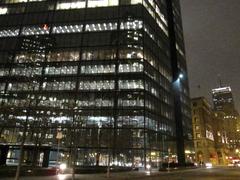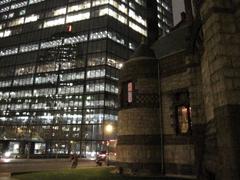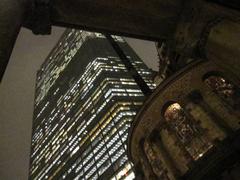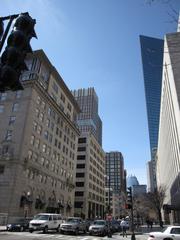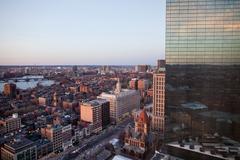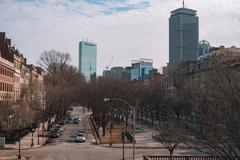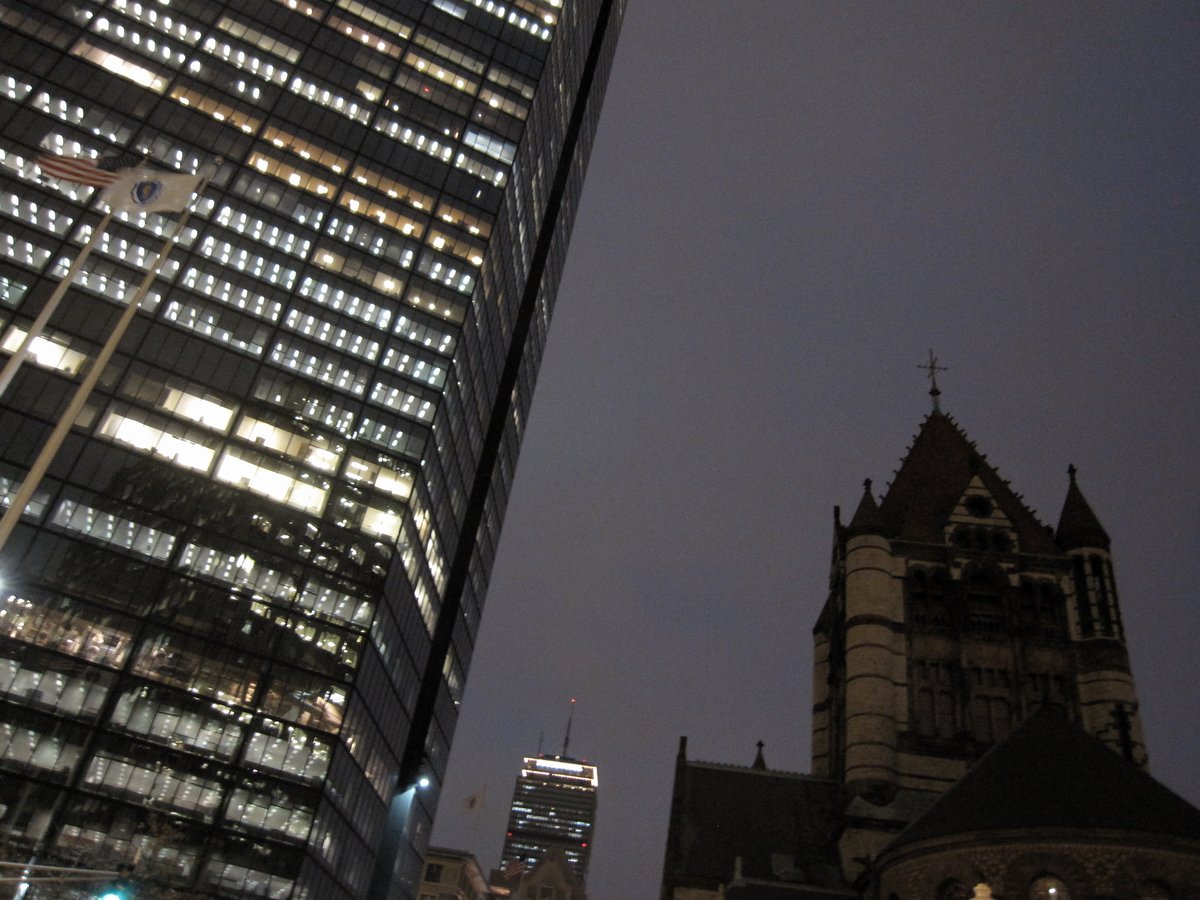
John Hancock Tower Boston: Visiting Hours, Tickets, and Travel Guide
Date: 14/06/2025
Introduction: Historical Significance & Visitor Overview
The John Hancock Tower, officially 200 Clarendon Street, stands as Boston’s tallest building and a celebrated icon of modern architectural innovation. Dominating the Back Bay skyline at 790 feet and 60 stories, its sleek glass façade—designed by Henry N. Cobb of I. M. Pei & Partners—has redefined Boston’s cityscape since its completion in 1976. The tower’s reflective blue exterior harmonizes with nearby historic sites like Trinity Church and the Boston Public Library, making it a pivotal landmark for both architecture aficionados and casual visitors. Despite formidable engineering challenges during its construction—including foundational issues, glass panel failures, and the subsequent implementation of tuned mass dampers—the tower has earned acclaim for its design ingenuity and resilience. While the Skywalk Observatory closed permanently in 2020, the building remains a must-see for its exterior beauty and proximity to numerous Boston historical sites. This guide offers up-to-date details on visiting hours, accessibility, nearby attractions, travel tips, and more to help you make the most of your visit (docomomo-us.org, en.wikipedia.org, Boston Globe).
Table of Contents
- Introduction
- Historical Context and Construction
- Visiting the John Hancock Tower
- Practical Travel Information
- Frequently Asked Questions (FAQ)
- Conclusion
- Explore More
1. Historical Context and Construction
Early Vision and Urban Context
The John Hancock Tower represents a transformative moment in Boston’s urban development. In a city long resistant to modern skyscrapers, its construction in the heart of Copley Square marked a significant departure from the low-rise landscape. The site itself had a storied past, notably as the location of the Westminster Hotel, which had already sparked debates about height restrictions as early as 1903 (docomomo-us.org). The decision to erect a cutting-edge skyscraper here signaled Boston’s embrace of architectural ambition and modernity.
Design Competition and Architectural Innovation
In 1967, the John Hancock Mutual Life Insurance Company sought a new headquarters that would embody progress and corporate strength. Henry N. Cobb of I. M. Pei & Partners won the commission with a design that epitomized the International Style: a minimalist glass parallelogram, subtly oriented to minimize its visual impact on historic Trinity Church (en.wikipedia.org). The innovative reflective glass curtain wall was intended to mirror the sky and nearby landmarks, blending the new with the old (factbud.com).
Construction Timeline and Challenges
Foundation and Site Difficulties
Construction began in 1968 after protracted zoning debates. Engineers faced complex geotechnical conditions in Back Bay’s reclaimed marshland, requiring deep foundations to protect both the new tower and neighboring historic structures. Early excavation work caused settling at Trinity Church, which led to an $11.6 million settlement (boston.com).
Glass Façade Failures and Engineering Solutions
Shortly after installation, hundreds of the building’s 10,000+ glass panels—each weighing roughly 500 pounds—began to detach due to thermal stress and anchoring failures. For public safety, plywood temporarily replaced these panels, earning the moniker “Plywood Palace” (docomomo-us.org). Engineers also retrofitted the structure with massive tuned mass dampers to counteract wind-induced sway (en.wikipedia.org). These setbacks delayed completion by four years and doubled the budget to over $160 million, but ultimately pushed the boundaries of high-rise engineering (e-a-a.com).
Recognition and Legacy
Despite early challenges, the tower quickly became an architectural landmark, earning the American Institute of Architects’ National Honor Award in 1977 and the Twenty-five Year Award in 2011 (en.wikipedia.org).
2. Visiting the John Hancock Tower
Visiting Hours and Entry Procedures
As of June 2025, public access to the observation deck is no longer available, following the permanent closure of the Skywalk Observatory in 2020 (Boston Globe). However, visitors are welcome to enjoy the tower’s lobby and exterior plaza during business hours:
- Lobby and Plaza Hours: Monday–Friday, 8:00 AM – 6:00 PM
- Observation Deck: Permanently closed (no ticket sales)
- Entry: Security screening is required; check in at the lobby. Photography is permitted in public spaces, but professional equipment may need advance approval.
Accessibility
The lobby, exterior plaza, and surrounding sidewalks are wheelchair accessible with ramps and elevators. Accessible restrooms are not available inside the tower, but facilities can be found in the nearby Boston Public Library or Prudential Center.
Visitor Tips
- Best Times: Mornings and weekdays for fewer crowds and optimal lighting.
- Photography: Exterior shots are best at sunrise or sunset. Interior photography is allowed in the lobby (tripods and flashes may be restricted).
- Amenities: No public restrooms or observation decks. Dining and shopping are abundant in the Back Bay area.
3. Nearby Boston Historical Sites & Attractions
The tower’s Back Bay location puts you within easy reach of several top Boston historical sites:
- Trinity Church: National Historic Landmark, renowned for Romanesque architecture (Trinity Church Boston).
- Boston Public Library: Historic McKim Building with murals, courtyards, and free tours (Boston Public Library).
- Newbury Street: Famed for shopping, dining, and people-watching.
- View Boston at Prudential Center: The city’s premier observation deck since 2023, offering sweeping views including the John Hancock Tower (View Boston).
4. Practical Travel Information
Directions & Transportation
- Address: 200 Clarendon Street, Boston, MA 02116
- Green Line Subway: Copley Station (5-minute walk) (MBTA Map)
- Orange Line: Back Bay Station (10 minutes on foot)
- Parking: Public garages at Copley Place and Prudential Center ($20–$40/day). Limited metered street parking.
- Biking: Bluebikes stations nearby (Bluebikes)
Safety & Security
- Standard security screening at lobby entrance; bags may be checked.
- The Back Bay is generally safe, but use typical urban precautions, especially at night.
Family & Group Visits
- The open plaza and nearby attractions are family-friendly, though the lack of an observation deck means visits are typically brief.
- Groups planning professional photography or formal tours should contact building management in advance.
5. Frequently Asked Questions (FAQ)
Q: What are the John Hancock Tower visiting hours?
A: The lobby and plaza are open Monday–Friday, 8:00 AM–6:00 PM. The Skywalk Observatory is permanently closed.
Q: Do I need tickets to visit?
A: No tickets are required for lobby or exterior access. There are no observation deck tickets available.
Q: Is the building accessible for people with disabilities?
A: Yes, public areas and sidewalks are wheelchair accessible.
Q: Can I take photos inside the tower?
A: Yes, in the lobby, but check with security regarding equipment.
Q: What else can I do nearby?
A: Visit Trinity Church, Boston Public Library, Newbury Street, or the View Boston deck at Prudential Center.
6. Conclusion
Although interior panoramic views are no longer available due to the closure of the Skywalk Observatory, the John Hancock Tower remains an essential Boston landmark. Its architectural legacy, engineering triumphs, and location among some of the city’s most treasured sites make it a rewarding stop for anyone interested in the city’s history and innovation. Plan to visit during business hours to enjoy the lobby, admire the tower’s striking façade, and explore the rich cultural landscape of Back Bay. For the most current information, consult the official website (200 Clarendon).
7. Explore More
- Download the Audiala app for curated Boston travel guides, self-guided walking tours, and real-time updates.
For interactive maps and virtual tours of the Back Bay area, including the John Hancock Tower, visit the official Boston tourism website (Boston USA).
Sources
- John Hancock Tower, 1977, Wikipedia
- John Hancock Tower, Docomomo US, 2011
- When They Built the Hancock Tower and It Started Falling Apart, 2015, Boston.com
- Prudential Center’s Skywalk Observatory Close Permanently, 2020, Boston Globe
- Official John Hancock Tower Website, 2025
- Boston USA Tourism Portal, 2025

